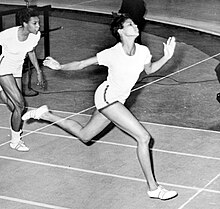by Charles Plant | Jul 31, 2012 | Leaders, Leadership Development

Watching the Olympics today I was reminded of the story of a woman who showed incredible perseverance to get to the Olympics, let alone emerge a champion.
Wilma Rudolph was born prematurely, the 20th of 22 siblings. At the age of four she contracted infantile paralysis (caused by the polio virus). Until she was nine, Wilma wore a brace on her left leg and foot (which had become twisted as a result) and for another two years, wore an orthopaedic shoe. In addition, by the time she was twelve she had survived bouts of scarlet fever, whooping cough, chickenpox, and measles.
In 1952, at the age of twelve, she followed in her sister’s footsteps and began to play basketball. In the tenth grade her potential was recognized in track and field which she had taken up to remain active between basketball seasons.
At 16, she earned a berth on the U.S. Olympic track and field team and came home from the 1956 Melbourne Games with an Olympic bronze medal in the 4 x 100 relay.
At the Rome Olympic Games in 1960, at the age of 20 she won the 100 meter, the 200 meter, and got her third gold in the 4 x 100 relay with a world record. After these wins, she was acclaimed “the fastest woman in history”. In 8 years she went from overcoming the effects of paralysis to Olympic glory, and became for me a great example of perseverance in the face of adversity.
by Charles Plant | Jul 26, 2012 | Leaders, Leadership Development

In the world of leaders who stay calm in the face of stressful situations, Corneille Ewango stands out for his courage and dedication. While he grew up in a family of poachers and hunters he got the chance to go to school and there he found a new mission, to study and preserve the flora and fauna of his region, the Congo Basin forest.
The Congo Basin’s great forests are, like many other fragile ecosystems, under pressure from external forces. Settlers are always on the hunt for fresh farmland and miners look for valuable ore deposits. Worst of all are the soldiers who have been fighting over the forests both as territory to be won and as a resource for bush meat and cooking charcoal. Ewango risked his life to defend his country’s extraordinary wilderness. As director of the Okapi Reserve’s botany program during its civil war he led efforts to protect the forest and its people from mass murder, rampant rape, and widespread destruction.
According to the National Geographic “He rallied 30 junior staff members and 1,500 forest residents to stand up to marauding militias and preserve crucial reserve data throughout years of war and chaos. He divided irreplaceable plant specimens, secretly distributing them to friends for safekeeping. Research materials and data files were strategically buried in the forest. For three months he hid in the dense vegetation himself, foraging for food alongside the very wildlife he sought to protect. “I knew if I left, everything could be lost. And I wanted to be there to rebuild immediately after the situation normalized.”
His leadership is an example to all of us who face adversity and strive to remain calm in stressful situations.
by Charles Plant | Jul 17, 2012 | Leaders, Leadership Development
 Time has passed since the Deepwater Horizon disaster in the Gulf of Mexico but it can teach us a lot about how to take responsibility in a crisis. BP’s CEO, Tony Hayward, ended up losing his job as a result of the disaster primarily because he failed to take responsibility for BP’s role in the disaster.
Time has passed since the Deepwater Horizon disaster in the Gulf of Mexico but it can teach us a lot about how to take responsibility in a crisis. BP’s CEO, Tony Hayward, ended up losing his job as a result of the disaster primarily because he failed to take responsibility for BP’s role in the disaster.
When held to account by Congress, Hayward repeatedly told members of Congress that it would be “premature” to prejudge the outcome of investigations into the explosion. He refused to be drawn into discussions as to the causes of the disaster and this continued stonewalling led to growing frustration on the part of Congress. He also reiterated his claim that he wasn’t personally involved in decisions relating to construction of the well.
In refusing to accept blame, Hayward failed to take responsibility.I’m sure he took responsibility for their prior results but failed in this one crucial aspect of leadership.
There may be some hope for RIM yet because its leader, Thorsten Heins, is taking responsibility for past errors. By taking responsibility for the past, he can then move the agenda towards the future and focus on Blackberry 10. He may have then the makings of a good leader and RIM may indeed pull itself out of its troubles as a result of effective leadership.
by Charles Plant | Jul 11, 2012 | Leaders, Leadership Development
 Leadership is a lot about making good decisions, developing a good strategy, having a vision. So when someone blows it completely, it’s worth noting. Today’s award for business infamy goes to William Orton, president of the Western Union Telegraph Company in 1876. At that time, the company had a monopoly on the telegraph, which at that time was the world’s most advanced communications device.
Leadership is a lot about making good decisions, developing a good strategy, having a vision. So when someone blows it completely, it’s worth noting. Today’s award for business infamy goes to William Orton, president of the Western Union Telegraph Company in 1876. At that time, the company had a monopoly on the telegraph, which at that time was the world’s most advanced communications device.
So wrapped up in the telegraph was Orton that when Gardiner Greene Hubbard, Alexander Graham Bell’s father-in-law, approached Orton with an offer to sell him a patent for the newly invented telephone for $100,000, Orton thought he was kidding.
Orton replied to Bell: “Mr Bell, after careful consideration of your invention, while it is an interesting novelty, we have come to the conclusion that it has no commercial possibilities…What use could this company make of an electrical toy?”
by Charles Plant | Jul 3, 2012 | Exercises, Leaders
Many companies use a rating system for employees in performance appraisals that puts them in classes like A,B,C or 1,2,3. The As and 1s are reserved for the very best employees or as it is frequently put, those whose work exceeds expectations. The Bs or 2s are for people whose work meets expectations and the Cs or 3s are for those whose work does not meet expectations. Simple eh? The problem is that no on knows what Meets Expectations means when compared with Exceeds Expectations. Many employees think that when they are doing their job very well as described in their job description, they’ll get an Exceeds Expectations. Sorry, doesn’t happen.
The difference between Meeting Expectations and Exceeding them is Initiative
The secret to being an A employee, a 1, or an Exceeds Expectations and thereby getting a promotion, raise or bigger bonus means doing more than what was expected of you at work. That means you must do more than what was in your job description. If someone tells you to do something and you do it, even if you do it very well, you are still only Meeting Expectations. That is because you are expected to do what you are asked to do and you are expected to do it very well or you wouldn’t be working there very much longer.
To do more than what was expected of you at work, you need to use initiative. That means you must find something important that needs to be done and is not part of your regular job and do it. That’s all the difference between an A and a B, initiative.
 Try this at work:
Try this at work:
Find some small thing that people recognize is a problem and fix it. It could be as simple as finding a better way to deal with contact information, a better way to keep track of projects, a better way to get approval for expenditures.
Once you have picked this thing to improve, then fix it and let everyone know what you have done and why. This communication is not for tooting your own horn but to make sure the change is implemented by everyone. You might have to remind them several times.
After you’ve tried out this initiative once, keep doing it. Find something else to fix or start and start it. Keep doing small things that are outside the scope of your job and then start making those things bigger. Work up to major projects and pretty soon you’ll be noted for your initiative.
by Charles Plant | Jun 27, 2012 | Leaders, Leadership Development
 On January 1st, Virginia Rometty became IBM’s first female CEO. She graduated as an engineer in 1979 and joined IBM in 1981 at a time when women were coming to enter the business world in droves. Along with the requisite skill, and emotional intelligence, one of the things that Rometty credits for her rise to the top is self confidence.
On January 1st, Virginia Rometty became IBM’s first female CEO. She graduated as an engineer in 1979 and joined IBM in 1981 at a time when women were coming to enter the business world in droves. Along with the requisite skill, and emotional intelligence, one of the things that Rometty credits for her rise to the top is self confidence.
As reported in the New York Times: “The age group of women becoming C.E.O.’s started their careers in the early ’80s, when the huge tsunami of women were really building professional lives,” said Ilene H. Lang, chief executive of Catalyst, a research firm on women and business.”
“Yet the fact that Ms. Rometty’s gender remains newsworthy also exposes the lengths that businesses still need to go to before women who invest their careers in companies have a shot at the corner office, or even equal representation. Early in her career, Virginia M. Rometty, IBM’s next chief executive, was offered a big job, but she felt she did not have enough experience. So she told the recruiter she needed time to think about it.”
“That night, her husband asked her, “Do you think a man would have ever answered that question that way?” “What it taught me was you have to be very confident, even though you’re so self-critical inside about what it is you may or may not know, and that, to me, leads to taking risks.”






